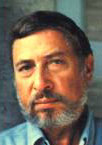|
|
Bernard Heuvelmans
(10 October 1916 - 22 August 2001)

"Our world is saturated with mystery. It would seem that we are
surrounded by question marks. Everything about us gives rise to
questions, to which we know full well that there are, alas, no answers.
At least no precise and definitive answers."
"It is strange how many men of science lack any
curiosity."
Bernard Heuvelmans: Sur la piste des Bêtes ignorées
Born on 10 October 1916 in Le Havre, France, Bernard Heuvelmans
earned a doctorate in science from the Free University of Brussels at
the age of 23. His thesis was a study of the teeth of Orycteropus,
an African mammal that is strange if only because it is the sole
member of the order Tubulidentata.
He published many scientific works, including some in the bulletin of the
Royal Museum of National History of Belgium. A humanist and zoologist,
he published two works at the end of the war:
L'Homme au creux de l'Atome (1943) and L'Homme parmi les étoiles
(1944).
In 1947, he moved to Paris and took up residence in the Saint-Germain-des-Prés
district. There he found work as a jazz musician and actor.
Starting in 1948 he was attracted by the enigmas of animals that were
still unknown to science, the existence of which has not yet been proven
by irrefutable evidence, but which is based more on clues, traces, legends, bits of remains and even 'dubious' photos.
In 1955 he published Sur la piste des Bêtes ignorées
(On the Track of Unknown Animals), a book which has been translated into
many languages and sold over a million copies.
In it, he laid the foundation for a new scientific discipline: cryptozoology, the science of unknown animals.
This was followed by Dans le sillage des Monstres marins : le Kraken et
le Poulpe colossal (1958), Le Grand Serpent-de-Mer : le mystère
zoologique et sa solution (1965), L'Homme de Néanderthal est toujours vivant (with
Boris F. Porchev, 1974, a work which recounts the discovery of an
unknown hominid that he called Homo pongoides), Le Dernier Dragon d'Afrique
(1978) and La Bête Humaine d'Afrique (1980).
In 1975 he founded the first world centre for cryptozoological
research in the Dordogne region of France, where he had amassed a unique
collection of documents.
Bernard Heuvelmans was appointed president of the International
Society of Cryptozoology of the Smithsonian Institution. He published
many articles in Cryptozoology magazine.
In 1988 the Centre for Cryptozoology moved to Le Vésinet, on
the outskirts of Paris, where Bernard Heuvelmans lived.
In 1999, he contributed all of his documents and archives to the
Cantonal Museum of Zoology in Lausanne, Switzerland.
Bernard Heuvelmans died on 22 August 2001.
The staff of the Surnateum would like to take this opportunity to pay
their respects to Bernard Heuvelmans and to Monique Watteau. His
research protocol for cryptozoology has proven to be an extremely useful
working method for detecting hauntiques.
|
|

